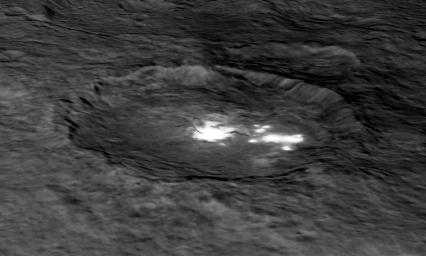
|
Occator Crater in Perspective
- Click the image above for a larger view
- Full-Res JPEG (1734 x 1043) (146.3 kB)
- Full-Res TIFF (1734 x 1043) (1.2 MB)
Caption:
An image of Occator Crater draped over a digital terrain model provides a 3-D-like perspective view of the impact structure. Several bright areas can be seen in this crater. The inner part of the crater forms a type of "crater within a crater" measuring about 6 miles (10 kilometers) in diameter and 0.3 miles (0.5 miles) in depth, and contains the brightest material on all of Ceres. Occator measures about 60 miles (90 kilometers) wide.
With its sharp rim and walls, and abundant terraces and landslide deposits, Occator appears to be among the youngest features on Ceres. Dawn mission scientists estimate its age to be about 78 million years old.
Background Info:
Dawn's mission is managed by JPL for NASA's Science Mission Directorate in Washington. Dawn is a project of the directorate's Discovery Program, managed by NASA's Marshall Space Flight Center in Huntsville, Alabama. UCLA is responsible for overall Dawn mission science. Orbital ATK, Inc., in Dulles, Virginia, designed and built the spacecraft. The German Aerospace Center, the Max Planck Institute for Solar System Research, the Italian Space Agency and the Italian National Astrophysical Institute are international partners on the mission team. For a complete list of acknowledgments, see http://dawn.jpl.nasa.gov/mission .
For more information about the Dawn mission, visit http://dawn.jpl.nasa.gov .
Cataloging Keywords:
| Name | Value | Additional Values |
|---|---|---|
| Target | 1 Ceres | |
| System | Main Belt | |
| Target Type | Dwarf Planet | Asteroid |
| Mission | Dawn | |
| Instrument Host | Dawn | |
| Host Type | Orbiter | |
| Instrument | Framing Camera (FC) | |
| Detector | ||
| Extra Keywords | Crater, Grayscale, Impact | |
| Acquisition Date | ||
| Release Date | 2015-12-09 | |
| Date in Caption | ||
| Image Credit | NASA/JPL-Caltech/UCLA/MPS/DLR/IDA | |
| Source | photojournal.jpl.nasa.gov/catalog/PIA20179 | |
| Identifier | PIA20179 | |
